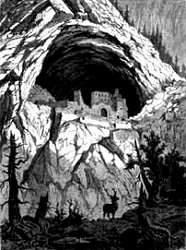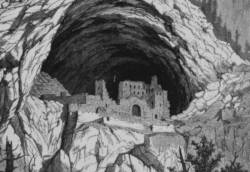Höhlenschoß Puxer Luegg
Höhlenschoß Schallaun
Useful Information

| Location: |
8833 Teufenbach.
96 between Teufenbach and Niederwölz, turn off on road to Schloss Pux. The trail starts 900 m from the turnoff on the right side of the road. Limited parking possibilities, steep ascend. (47.1378825, 14.3476958) |
| Open: |
no restrictions. [2024] |
| Fee: |
free. [2024] |
| Classification: |
 Karst Cave Karst Cave
 Cave Castle Cave Castle
|
| Light: | bring torch |
| Dimension: | A=937 m asl. |
| Guided tours: | self guided |
| Photography: | allowed |
| Accessibility: | no |
| Bibliography: |
Thomas Kühtreiber, Josef Weichenberger (2013): Unterirdische Gänge auf Burgen – eine Spurensuche, Stadt – Land – Burg. Festschrift für Sabine Felgenhauer-Schmiedt zum 70. Geburtstag. Studia honoraria 34, Rahden/Westf. 2013, pp 237-248. researchgate 
E. C. Nôller (1966): Exkursion und Erkundung an den Höhlenburgen Luegg und Schalaun Burgen und Schlösser - Zeitschrift für Burgenforschung und Denkmalpflege, Bd. 7 Nr. 1, pp 21-24, Dt. Burgenvereinigung e. V. ; Europäisches Burgeninstitut, ISSN: 0007-6201. DOI pdf 
|
| Address: | Höhlenschoß Puxer Luegg, 8833 Teufenbach. |
| As far as we know this information was accurate when it was published (see years in brackets), but may have changed since then. Please check rates and details directly with the companies in question if you need more recent info. |
|
History
| 12th century | castle built by the Lueger. |
| 1181 | first written mention of a Machwardus de Schalun. |
| 1416 | after the death of Ulrich der Pranckher, his widow Anne and others became owners. |
| 1436 | a fief of the Counts of Cilli, and they enfeoffed Tristram Teufenbach with it. |
| 1533 | Georg von Teufenbach received the castle in fief from King Ferdinand I - combined with the obligation to guarantee the royal men free access to the castle. |
| 1551 | Franz und Bernhard von Teufenbach become owner. |
| 1586 | Otto von Teufenbach becomes owner. |
| 1613 | Rudolf Freiherr von Teufenbach becomes owner. |
| 1748 | owned by Franz Gottlieb, Freiherr von Putterer. |
| 1752 | sold to the Archbishop of Salzburg. |
| 1769 | Carl Graf Lengheim becomes owner. |
| 1820 | Alois Graf Trautmannsdorf becomes owner. |
Description

Puxer Luegg and Schallaun are two medieval cave castles in the Puxer Wand (Cliff of Pux). They are also called Puxerloch (Pux Hole). This limestone cliff is located north of the town Teufenbach in the Mur valley. It is the southern slope of the Pleschaitz mountain.
The cave castles were owned by the families Teufenbacher, Liechtensteiner, and Pranckh. According to local legend, they were used by a group of Raubritter (marauding knights) and were cleared by Hungarian soldiers. Actually, the castle was occupied by the Hungarians during the Hungarian War, and they were forced to leave in 1490. Much later during the 19th century, the castle was used by robbers as a hideout, and when they were captured the castle was destroyed. Nevertheless, the Puxer Luegg castle was lived in until the 19th century. Today the cave castles and the château below are owned by the Pranckh family.
The Luegg castle is a huge portal which is about 40 wide and 40 m high. It narrows fast, and there is a much smaller entrance hall which is about 8 to 12 m high, and about 20 m long. On the left wall a cave passage starts, which leads to a place called Wasserloch (water hole) after 40 m, which was probably a way to obtain drinking water. It is an artificial cistern intended to collect dripping water. It is unclear if this was only a fallback in the case of a siege, or if it was used regularly. The cave has additional passages, but unlike stated in the legends, there is neither a secret exit nor a connection to nearby Schallaun cave castle. A legend says the two caves were connected by a passage through the rock, but this passage was never found. E. C. Nôller guesses that this is the result of the destruction of both castles in the early 19th century. A group of robbers was using hideouts all over the country, including the still existing cave castles. In an attempt to stop them the government destroyed the hideouts, which included the demolition of the cave castles with explosives. There is the possibility that the explosion caused the collapse of a cave passage.
The road to Schloss Pux, the much younger successor, runs along the foot of the cliff. From here the cave castle can be easily seen. Walking up to the castle requires a little fitness and surefootedness, basic mountaineering equipment is much recommended. This includes good walking shoes, comfortable clothes, raincoat and sun protection. It is necessary to ascend the steep slope through trees and across almost vertical sections. The steepest parts have lately been equipped with staircases, so it is now manageable, but still not suitable für handicapped or elderly. The castle is 187 m higher than the river Mur.
Schallaun is located 70 m west of Luegg and a little deeper, and was once connected with a wooden bridge along the cliff face. This bridge is long gone and the only way to the cave castle is to climb the vertical wall. According to tradition, Schallaun is derived from Chalons. During Charlemagne’s reign, a knight from Chalons eloped with a Saxon princess and fled to the cave where he built his castle.
Charlemagne, the mighty ruler of the Frankish people, had fought the battle against the warlike Saxons and celebrated the feat with a sumptuous victory banquet.
Again and again, the favourite noble boy Charlot of Chalon had the king’s cup filled to soothe the heated tempers.
The question was what was to become of the 30,000 captured Saxons, including the two daughters of the fallen Saxon king.
Both were entrusted to Charlot.
The nobleman took pity on the two daughters and left the glittering life at the Frankish court.
So he fled and discovered the rock cave in the Mur valley.
When the warlike times were over and Charlot of Chalon no longer had to fear treachery, he built the cave castle of Schallaun.
He married one of the two sisters and became the ancestor of a feared robber-knight dynasty.
Romuald Pramberger (1937): Burgsagen aus Steiermark, Seckau 1937, S. 55.
online
Another local legend says that Schallaun was haunted by a shadowless man who was desperate about his marriage prospects because of the curse. He hid in the permanent shadows of the cave. He only emerged on moonless nights, abducted a passing peasant girl and carried her back into the shadowless depths of Schallaun. However, Pater Romuald Pramberger, a Benedictine monk who collected legends and fairy tales, has a more detailed version:
The man without a shadow.
The Pfleger on Stein had two children, a daughter, and a son named Erasmus, and over in the cave castle of Schallaun the old owner of the castle also had two children, a son and a daughter named Bertha.
As it happens, these young people liked each other very well, but the Pfleger on Stein, a very cruel man, did not like that at all.
Then the lady of Schallaun Castle died, and the siblings from Stein Castle came over to Kühlenburg to comfort their loved ones at their mother’s bier.
But the enraged keeper hurried after them, and when he found the four young people at the bier, he slew his own daughter and her lover.
But Erasmus beat back the raging father and fled the terrible place.
He still heard his father’s curse: "May your own shadow destroy you!"
The Pfleger then rummaged through the cave and found a fragment of a letter.
From the few lines he deduced that he had murdered his own son Erasmus.
Half mad with remorse, he presented himself to the court in Stein Castle and had to endure the most bitter tortures.
Erasmus and Bertha, however, had meanwhile found lodgings at the foot of the Eisenhut and were able to eke out a meagre living here.
Then Erasmus heard of the Freimannshöhle (Freeman’s Cave), where immense treasures were stored, carefully guarded by a ghost in the shape of a freeman.
He visited him in the coolness, and asked him for enough money to feed himself and Bertha, and had to pledge his shadow in return.
"Don’t forget," said the ghost, handing over the money, "that the moment you demand the shadow from me, your life will be exchanged for the shadow."
They both lived happily for a few days.
But when they wanted to dance on Kirchtag, the people noticed that Erasmus was without a shadow and fled from him.
He therefore emigrated with Bertha to the Sölktal.
But even here they found no peace.
When they heard that the keeper of Stein was about to be executed, they hurried back home.
On the way, Bertha died and found her final resting place in the forest.
In Teuffenbach, Erasmus heard talk of the high court to be held the next day, which is why he rushed straight up to Stein Castle.
He knew every nook and cranny here.
He found the court beadle asleep, took the dungeon key, unlocked the dungeon, broke his father’s shackles and took him secretly to Puxerloch to a servant of the deceased woman.
Then he hurried back to Stein, where he took his father’s place in the dungeon.
How surprised the chief magistrate and his men were the next morning.
After Erasmus had told them that he had slain his father and had buried him in the forest, and had also shot some peasants in the Sölk, he was sentenced to death by the sword.
"Take your mysterious gift, corrupt spirit!" whispered Erasmus.
His shadow loomed large and beautiful the moment his head fell from his torso.
"He dies innocent," cried a voice. It was the voice of the father, who then sank to the ground dead at his son’s side.
(Re-told after Schmutz.)
Romuald Pramberger (1937): Burgsagen aus Steiermark, Seckau 1937, S. 59.
online
The Maultaschin at Schallaun.
As the unholy woman Maultasch was waging war on the Mur valley, the lord of Schallaun castle disturbed her with raids.
She became so enraged that she stubbornly besieged the castle and half devastated it.
She did not succeed in conquering the castle, but the knight became so discouraged that he fled through an underground passage, whereupon it was easy for the fiend to storm and destroy the castle.
Shortly afterwards, however, she suffered a crushing defeat in the Blutgraben (blood trench) opposite the castle.
Romuald Pramberger (1937): Burgsagen aus Steiermark, Seckau 1937, S. 61.
online
- See also
 Search DuckDuckGo for "Puxer Luegg"
Search DuckDuckGo for "Puxer Luegg" Google Earth Placemark
Google Earth Placemark OpenStreetMap
OpenStreetMap Ruine Puxerloch - Wikipedia (visited: 17-JUL-2025)
Ruine Puxerloch - Wikipedia (visited: 17-JUL-2025) The Puxerloch Cave Castles (visited: 11-FEB-2022)
The Puxerloch Cave Castles (visited: 11-FEB-2022) BURG LUEGG | PUXERLOCH
BURG LUEGG | PUXERLOCH  (visited: 05-OCT-2021)
(visited: 05-OCT-2021) Burgruinen Schallaun/Luegg (Puxerloch)
Burgruinen Schallaun/Luegg (Puxerloch)  (visited: 05-OCT-2021)
(visited: 05-OCT-2021) Puxerloch: Seltene Höhlenburgen
Puxerloch: Seltene Höhlenburgen  (visited: 05-OCT-2021)
(visited: 05-OCT-2021)
 Index
Index Topics
Topics Hierarchical
Hierarchical Countries
Countries Maps
Maps